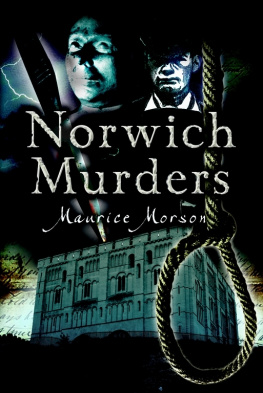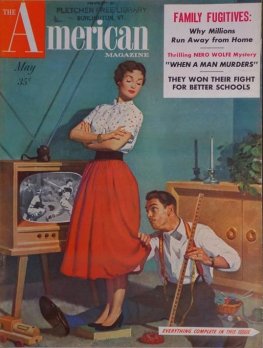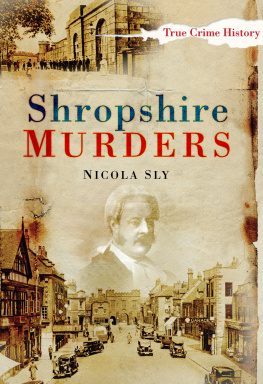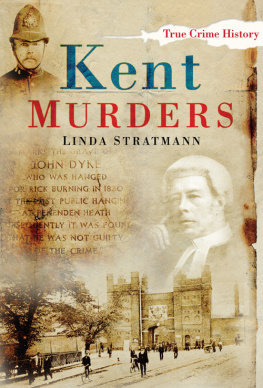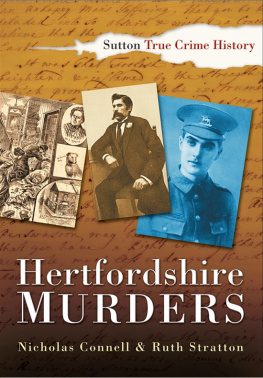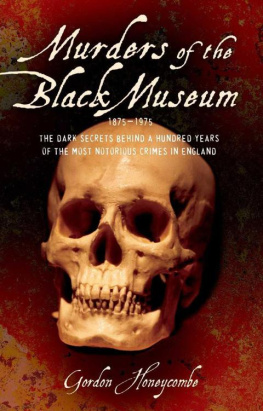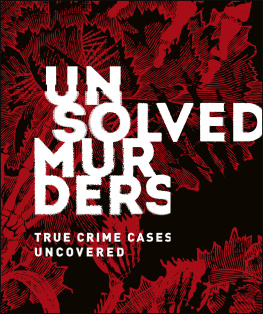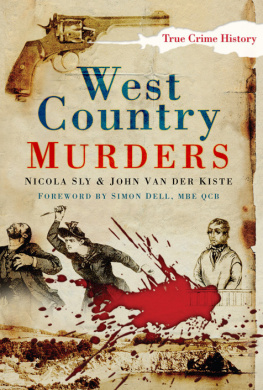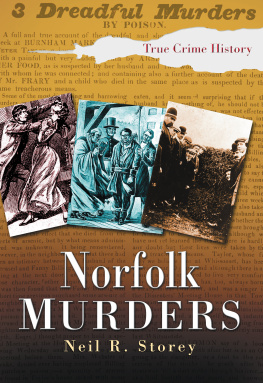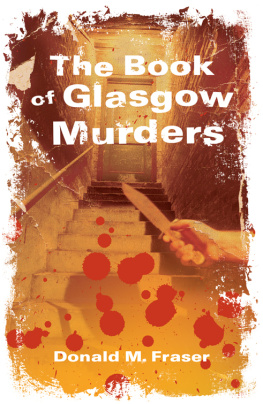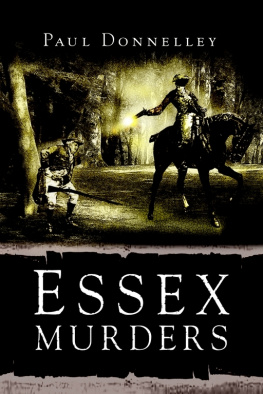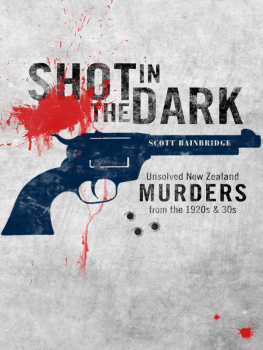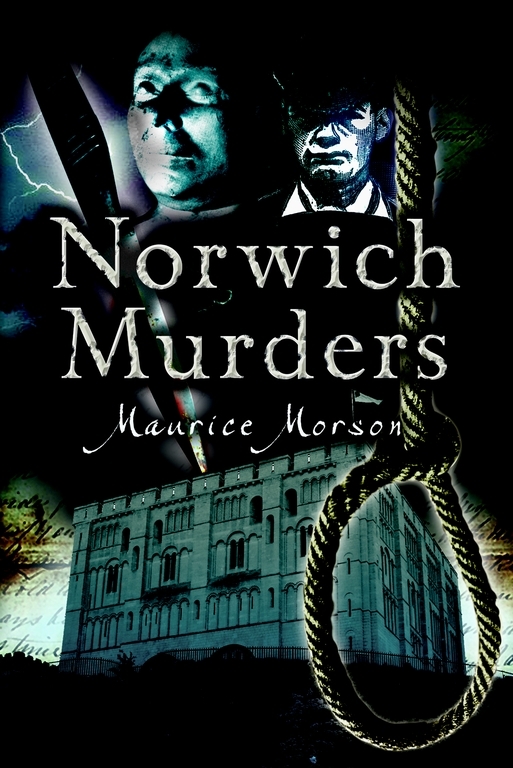Acknowledgements
I am grateful to all who assisted in the compilation of this book, in whatever role, whether named below or not.
My thanks go to the Chief Constable of the Norfolk Constabulary for permission to research and record from police files. Several retired and serving officers of the old city and county forces gave up their time and memories while the Norfolk Constabulary archivists searched and found and confirmed or corrected.
Numerous newspapers, some long gone, yielded information and illustrations and I am grateful to Archant (Norfolk) Ltd for permission to publish from several different titles.
The staff of the National Archives, Norfolk Heritage Centre, Norfolk Record Office and Archant Press Library guided and kept the research on the right track, and the departments of Norwich City Council responsible for the Guildhall and the Earlham Cemetery gave permission to view and record matters within their purview and supplied assisting staff. My thanks to all those unnamed persons in those organisations who so willingly and materially helped.
Some can be thanked by name: John Mason for his probing of police history, Philip Yaxley for his in-depth revelations of Wymondham history, Derek James for information and a pipeline to the public, Mike Page for excellent aerial photography, and Richard Barham, Peter Billington, Roger Brighton, Alan Brown, Dave Davies, John Dye, Herbert and Hilda Lines, John McLennan (now deceased), George Piercy (now deceased), Peter Pilgram, Jonathan and George Plunkett, Roger Sandall, Eddie Spelman, Malcolm Watt and Clive and Frieda Wilkins-Jones for their assistance in unearthing details of times past.
Special thanks go to modern illustrators capturing a previously unpictured past, Terry George and Dave Rowlands, and to all who supplied illustrations or the means to obtain them. Every effort has been made to identify copyright ownership and where pictures are not apparently copyrighted they are source credited. Pictures not apparently copyrighted and from multiple sources are not credited.
I am sensitive to those touched by the tragedies in this book and appreciate their co-operation and understanding. I am especially grateful to Evelyn Cousins for her fortitude and recall of painful times. She expressed a view that talking and writing of a loved one can in a sense bring them to life again. I hope that is the case and this book is so dedicated. History is not always nice but it is informative, educational and within the public domain. I am grateful to all who supported this view.
M. Morson, 2006
Bibliography
Norwich City Police Watch Committee Minutes
Chief Constable Reports to Norfolk Police Authority
Newspapers reports of: Norfolk Chronicle & Norwich Gazette, Norwich Mercury, Norfolk News, Norfolk Daily Standard, Eastern Daily Press and Eastern Evening News
National Archives: depositions, exhibits, Assize records etc.
Norfolk Heritage Centre reports, records etc.
Norfolk Record Office reports, documents etc.
Norfolk Constabulary and Police Archive reports, records etc.
Norfolk Annals by Charles Mackie
A History of Norwich by Frank Meeres
Norwich in the Nineteenth Century by Christopher Barringer
Disappearing Norwich and Rambles in Old Norwich by George Plunkett
Epilogue
O n 1 January 1968 a new police administration erased the border of the city and county forces, a territorial difference much in evidence in this book. Future Norwich murders fell inside the new City Division, their investigation allied to a new force headquarters at Martineau Lane (opposite where Martha Sheward was partly found). And the twenty-first century saw yet another new police headquarters another place known to this book: Wymondham!
The incidence of murders in Norwich had varied considerably over two centuries and a long spell without the ultimate crime looked set to continue to the end of the Norwich City Police, scheduled for midnight, 31 December 1967. In the late evening of Saturday, 30 December 1967, a murder was reported.
Manuel Gomez, a watch repairer on Norwich Market, died on the pavement in Stevenson Road, battered to death with a road rammer after an argument had overflowed from a nearby house. Donald MacLennan, a general dealer, was charged with murder by the city police, a force that within hours would be renamed and integrated into a new force. MacLennan said he was drunk and couldnt remember anything that took place. A jury found him Not Guilty of murder but Guilty of manslaughter, reaching this verdict by a 10 2 majority: another innovation never envisaged by those pioneer policemen.
The latter part of the twentieth century saw investigative techniques moulded into Incident Room systems. National training came through New Scotland Yard and the Police College, the Home Offices love of acronyms exampled by MIRIAM (Major Incident Room Index and Action Management) and HOLMES (Home Office Large Major Enquiry System). HOLMES survives today, refined and constantly improving, inspired by computer technology. How the police of yesteryear would have marvelled. And what would they have made of the linking of victim and murderer by a magic formula known as DNA?
During the accelerating progress of the latter part of the twentieth century several murders occurred in Norwich but this book is not encyclopaedic and ends, as introduced, with the Norwich City Police, or nearly so, for murder knows no bounds. No person or place is sacred, including hospitals and prisons. In December 1875, a male patient in the Norfolk and Norwich Hospital ran amok in the childrens ward and murdered four boys aged between nine and fourteen years and, outside our time frame, in 1980, murder was committed inside Norwich Prison. (There would be another there before the end of the century.)
The 1980 murder demonstrates the utter tragedy of wilfully taking a life. A nineteen-year-old timid and inadequate young man, detained for theft from a linen line, volunteered a confession to rape, finding some sense of importance in the attention he then received. Magistrates remanded him to Norwich Prison. Detectives, uneasy over his confession, interviewed him in prison and, satisfied that he was innocent of rape, arranged for him to be brought before the Magistrates to withdraw the charge. That night a hardened London criminal strangled him in the hospital dormitory for no other reason than he was available. A young innocent man had been in the wrong place, at the wrong time. All the victims in this book were available and innocent, and in the wrong place at the wrong time.
CHAPTER 1
Death of a Policeman The Murder of Police Constable William Callow 1848
T he poverty and privations of the middle nineteenth century were well exampled in the city of Norwich. The majority of its inhabitants were crammed into squalid and inadequate houses fed by narrow lanes and pocket-sized yards, dependent upon primitive and shared sanitation, dragging water from wells or the fouled river and struggling for sufficient food and warmth. Street disturbances were not uncommon, usually prompted and fuelled by the ready availability and cheapness of ale, but in May and June 1848 riot and murder gripped the city, beginning at that symbol of hard times, the workhouse. Drunkenness was not the root cause for this tumult and tragedy, although it played a part inasmuch as the policeman was allegedly drunk, disorder flowed from the right of a husband to sleep with his wife.
The workhouse at St Andrews Bridge Street (previously called Blackfriars, eventually part of St Georges Street) usually contained over 250 men, women and children, the total and turnover varying with an unremitting death rate. They were bound by hard work and hard rules. The trouble began with a new rule, made by the Poor Law Commissioners under an enabling Act of Parliament, decreeing that husbands should be separated from their wives at night. This edict was roundly condemned by the local movement of Chartists, vigorously led by John Love.

